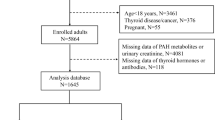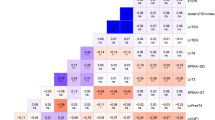Abstract
Considering the possible effects of polycyclic aromatic hydrocarbons (PAHs) on thyroid function, the current study aims to investigate the association of PAH urinary metabolites with the level of thyroid hormones in a sample of Iranian children and adolescents. This cross-sectional study was conducted from September 2015 to July 2016 in Isfahan, Iran. Participants were 150 students, aged 6–18 years, who were selected by multistage cluster random sampling from schools of Isfahan province. Blood and urine samples of participants were obtained for measurement of thyroid hormone levels (measured by immunoradiometric assay) and PAH urinary metabolites, including 1-hydroxynaphthalene, 2-hydroxynaphthalene, 9-hydroxyphenanthrene, and 1-hydroxypyrene. The association of serum thyroid-stimulating hormone (TSH) and PAH urinary metabolites was determined by correlation and regression analyses. Multivariate regression analysis revealed significant association between serum TSH and PAH urinary metabolites; this association remained significant after adjustment for gender and age. The corresponding figures were r = 0.85 for 1-naphthol, r = 0.86 for 2-naphthol, r = 0.87 for 1-hydroxypyrene, and r = 0.42 for 9-phenantrol, respectively, all p values < 0.001. The mean levels of 1-hydroxypyrene and 9-phenanthrol were higher in boys than those in girls (p < 0.05). The findings of this study indicated significant positive association between urinary PAH biomarkers and the TSH level in children and adolescents. It can be suggested that long-term exposure to PAHs might result in thyroid function impairment. The clinical implication of the current findings should be confirmed by future longitudinal studies.

Similar content being viewed by others
References
ATSDR (Agency for Toxic Substances and Disease Registry) (2005) Toxicological profile for naphthalene, 1-methylnaphthalene, and 2-methylnaphthalene. ATSDR, Atlanta
Brar NK, Waggoner C, Reyes JA, Fairey R, Kelley KM (2010) Evidence for thyroid endocrine disruption in wild fish in San Francisco Bay, California, USA. Relationships to contaminant exposures. Aquat Toxicol 96:203–215. https://doi.org/10.1016/j.aquatox.2009.10.023
Buratti M, Campo L, Fustinoni S, Cirla PE, Martinotti I, Cavallo D et al (2007) Urinary hydroxylated metabolites of polycyclic aromatic hydrocarbons as biomarkers of exposure in asphalt workers. Biomarkers 12:221–239
Burstyn I, Kromhout H, Partanen T, Svane O, Langard S, Ahrens W et al (2005) Polycyclic aromatic hydrocarbons and fatal ischemic heart disease. Epidemiology 16:744–750
CDC (2005) Third national report on human exposure to environmental chemicals. Centers for Disease Control and Prevention, Atlanta http://www.cdc.gov/exposurereport/3rd/pdf/thirdreport.pdf
Chetiyanukornkul T, Toriba A, Kameda T, Tang N, Hayakawa K (2006) Simultaneous determination of urinary hydroxylated metabolites of naphthalene, fluorene, phenanthrene, fluoranthene and pyrene as multiple biomarkers of exposure to polycyclic aromatic hydrocarbons. Anal Bioanal Chem 386:712–718
De Craemer S, Croes K, van Larebeke N, Sioen I, Schoeters G, Loots I et al (2016) Investigating unmetabolized polycyclic aromatic hydrocarbons in adolescents’ urine as biomarkers of environmental exposure. Chemosphere 155:48–56. https://doi.org/10.1016/j.chemosphere.2016.04.017
Duntas LH (2002) Thyroid disease and lipids. Thyroid 12:287–293
Farzan SF, Chen Y, Trachtman H, Trasande L (2016) Urinary polycyclic aromatic hydrocarbons and measures of oxidative stress, inflammation and renal function in adolescents: NHANES 2003-2008. Environ Res 144:149–157. https://doi.org/10.1016/j.envres.2015.11.012.
Fowles JR, Banton MI, Boogaard PJ, Ketelslegers HB, Rohde AM (2016) Assessment of petroleum streams for thyroid toxicity. Toxicol Lett 254:52–62. https://doi.org/10.1016/j.toxlet.2016.05.001
Goldstein JA, Taurog A (1968) Enhanced biliary excretion of thyroxineglucuronide in rats pretreated with benzpyrene. Biochem Pharmacol 17:1049–1065
Hollowell JG, Staehling NW, Flanders WD, Hannon WH, Gunter EW, Spencer CA et al (2002) Serum TSH, T (4), and thyroid antibodies in the United States population (1988 to 1994): National Health and Nutrition Examination Survey (NHANES III). J Clin Endocrinol Metab 87:489–499
Hua G, Broderick J, Semple KT, Killham K, Singleton I (2007) Rapid quantification of polycyclic aromatic hydrocarbons in hydroxypropyl-beta-cyclodextrin (HPCD) soil extracts by synchronous fluorescence spectroscopy (SFS). Environ Pollut 148:176–181
Izawa H, Kohara M, Watanabe G, Taya K, Sagai M (2007) Effects of diesel exhaust particles on the male reproductive system in strains of mice with different aryl hydrocarbon receptor responsiveness. J Reprod Dev 53:1191–1197
Jain RB (2016) Association between polycyclic aromatic hydrocarbons and thyroid function among males and females: data from NHANES 2007-2008. Int J Environ Health Res 20:1–15. https://doi.org/10.1080/09603123.2015.1135311.
Kataria A, Trasande L, Trachtman H (2015) The effects of environmental chemicals on renal function. Nat Rev Nephrol 11:610–625. https://doi.org/10.1038/nrneph.2015.94
Kelishadi R, Poursafa P (2014) A review on the genetic, environmental, and lifestyle aspects of the early-life origins of cardiovascular disease. Curr Probl Pediatr Adolesc Health Care 44(3):54–72. https://doi.org/10.1016/j.cppeds.2013.12.005
LaFranchi S (2011) Disorders of the thyroid gland. In: Kliegman R, Behrman R, Jenson H, Stanton B (eds) Nelson textbook of pediatrics, 19th edn. Elsevier, Philadelphia, pp 557–561
Li Z, Mulholland JA, Romanoff LC, Pittman EN, Trinidad DA, Lewin MD et al (2010) Assessment of non-occupational exposure to polycyclic aromatic hydrocarbons through personal air sampling and urinary biomonitoring. J Environ Monit 12:1110–1118
Li J, Lu S, Liu G, Zhou Y, Lv Y, She J et al (2015) Co-exposure to polycyclic aromatic hydrocarbons, benzene and toluene and their dose-effects on oxidative stress damage in kindergarten-aged children in Guangzhou, China. Sci Total Environ 524-525:74–80. https://doi.org/10.1016/j.scitotenv.2015.04.020
Maqbool F, Mostafalou S, Bahadar H, Abdollahi M (2016) Review of endocrine disorders associated with environmental toxicants and possible involved mechanisms. Life Sci 145:265–273. https://doi.org/10.1016/j.lfs.2015.10.022
Moorthy B, Chu C, Carlin DJ (2015) Polycyclic aromatic hydrocarbons: from metabolism to lung cancer. Toxicol Sci 145:5–15. https://doi.org/10.1093/toxsci/kfv040
Newman WC, Moon RC (1967) Altered thyroxine metabolism resulting from the chemical carcinogen 3-methylcholanthrene. Endocrinology 80:896–900
Paul KB, Hedge JM, Macherla C, Filer DL, Burgess E, Simmons SO et al (2013) Cross-species analysis of thyroperoxidase inhibition by xenobiotics demonstrates conservation of response between pig and rat. Toxicology 312:97–107. https://doi.org/10.1016/j.tox.2013.08.006
Poursafa P, Amin MM, Hajizadeh Y, Mansourian M, Pourzamani H, Ebrahim K et al (2017) Association of atmospheric concentrations of polycyclic aromatic hydrocarbons with their urinary metabolites in children and adolescents. Environ Sci Pollut Res Int 24(20):17136–17144. https://doi.org/10.1007/s11356-017-9315-8
Ramesh A, Walker SA, Hood DB, Guillén MD, Schneider K, Weyand EH (2004) Bioavailability and risk assessment of orally ingested polycyclic aromatic hydrocarbons. Int J Toxicol 23:301–333
Romanoff LC, Li Z, Young KJ, Blakely NC, Patterson DG Jr, Sandau CD (2006) Automated solid-phase extraction method for measuring urinary polycyclic aromatic hydrocarbon metabolites in human biomonitoring using isotope-dilution gas chromatography high-resolution mass spectrometry. J Chromatogr B Anal Technol Biomed Life Sci 835:47–54
Schmutzler C, Gotthardt I, Hofmann PJ, Radovic B, Kovacs G, Stemmler L (2007) Endocrine disruptors and the thyroid gland–a combined in vitro and in vivo analysis of potential new biomarkers. Environ Health Perspect 115:77–83. https://doi.org/10.1289/ehp.9369
Scinicariello F, Buser MC (2014) Urinary polycyclic aromatic hydrocarbons and childhood obesity: NHANES (2001-2006). Environ Health Perspect 122:299–303. https://doi.org/10.1289/ehp.1307234.
Skakkebaek NE, Toppari J, Söder O, Gordon CM, Divall S, Draznin M (2011) The exposure of fetuses and children to endocrine disrupting chemicals: a European Society for Paediatric Endocrinology (ESPE) and Pediatric Endocrine Society (PES) call to action statement. J Clin Endocrinol Metab 96:3056–3058. https://doi.org/10.1210/jc.2011-1269
Song M, Kim YJ, Park YK, Ryu JC (2012) Changes in thyroid peroxidase activity in response to various chemicals. J Environ Monit 14:2121–2126. https://doi.org/10.1039/c2em30106g
Sun H, Shen OX, Xu XL, Song L, Wang XR (2008) Carbaryl, 1-naphthol and 2-naphthol inhibit the beta-1 thyroid hormone receptor-mediated transcription in vitro. Toxicology 249:238–242. https://doi.org/10.1016/j.tox.2008.05.008
Wu MT, Lee LH, Ho CK, SC W, Lin LY, Cheng BH et al (2004) Environmental exposure to cooking oil fumes and cervical intraepithelial neoplasm. Environ Res 94:25–32
Xu X, Cook RL, Ilacqua VA, Kan H, Talbott EO, Kearney G (2010) Studying associations between urinary metabolites of polycyclic aromatic hydrocarbons (PAHs) and cardiovascular diseases in the United States. Sci Total Environ 408:4943–4948. https://doi.org/10.1016/j.scitotenv.2010.07.034.
Xu X, Hu H, Kearney GD, Kan H, Sheps DS (2013) Studying the effects of polycyclic aromatic hydrocarbons on peripheral arterial disease in the United States. Sci Total Environ 461–462:341–347. https://doi.org/10.1016/j.scitotenv.2013.04.089
Zhu P, Bian Z, Xia Y, Han Y, Qiao S, Zhao R et al (2009) Relationship between urinary metabolites of polycyclic aromatic hydrocarbons and thyroid hormone levels in Chinese non-occupational exposure adult males. Chemosphere 77:883–888. https://doi.org/10.1016/j.chemosphere.2009.08.054
Author information
Authors and Affiliations
Corresponding author
Ethics declarations
Written informed consent was obtained from parents and oral assent from students. The study was approved by the regional Ethics committee of Isfahan University of Medical Sciences (Project No. 194274).
Additional information
Responsible editor: Philippe Garrigues
Appendix
Appendix
Rights and permissions
About this article
Cite this article
Kelishadi, R., Sobhani, P., Poursafa, P. et al. Is there any association between urinary metabolites of polycyclic aromatic hydrocarbons and thyroid hormone levels in children and adolescents?. Environ Sci Pollut Res 25, 1962–1968 (2018). https://doi.org/10.1007/s11356-017-0577-y
Received:
Accepted:
Published:
Issue Date:
DOI: https://doi.org/10.1007/s11356-017-0577-y




